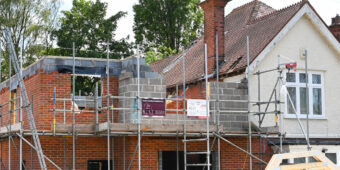When it pours, what’s your plan?
11 May 2013, Builders business

Q: As the weather starts to turn, some outdoor work may need to be put on hold. How do you manage timeframe expectations for your clients?
Firm: Peter Goodger Building
Principal: Peter Goodger
Location: Gore
Staff: 5 builders
I went into business 30 years ago, when I was 18, so I’ve been through a lot of bad weather!
It’s not really a factor you can plan for, so you really need to take it as it comes.
While it’s a good idea to have some dry weather jobs (indoor work) lined up for those soggy days, that might not always work out. It’s often difficult to put off finishing a job, just so you can have a wet weather plan!
What has helped is the drier winters, which means there’s been less time lost. We just finished a big job in Queenstown and never lost a day!
One important step is to ensure that clients understand weather delays are a possibility, particularly if they have a strict deadline. It’s also useful to explain why they occur – it’s not that builders don’t want to work outside on a rainy day, it’s that certain jobs, such as plastering and concrete, require certain conditions to be done correctly.
Concrete is particularly finicky, as it can’t be too cold, too hot or too windy because of cracking issues. If the weather doesn’t co-operate, it’s not worth doing it just for the sake of time constraints. It’s important that homeowners understand that. It’s in a business owner’s best interests to keep their guys busy as well, so no one wants to be held up.
Firm: Heyhoe Builders
Principal: Chris Heyhoe
Location: Porirua
Staff: 7 builders, 3 apprentices
The market is still fairly competitive, so you don’t want to be loading on contingency for weather as far as dollars go.
A good way to manage it, if you have enough jobs on at the same time, is to run them at different stages. That way you have some indoor work to do elsewhere if the weather is atrocious.
That’s where it’s good to have full-time staff on an hourly wage – that way I can take them to another site, as they’re not specifically contracted to one job.
It’s important to gauge the situation carefully, as it can get to a point where the weather is so bad that it’s actually unproductive to continue working. For example, carting mud or using a machine in the wet ruins the building site.
Overall, there’s usually enough diversity that there will be something for your guys to do – it’s a fallacy that every time it rains, the guys sit in the tool shed cleaning tools!
Sometimes, if it’s so bad that they don’t want to work, they can choose to pack up and work a half day on Saturday instead. Either way, the work gets done and despite what everyone seems to think, Wellington weather’s not so bad!
Firm: Bradford Building Limited
Principal: Mark Wilson
Location: mid-Canterbury
Staff: 45 build, 40 pre-cast, 15 paint
We’ve been doing this a long time and have learned to allow for what we call downtime, which is most often weather related.
Normally there are an average number of days per year that are wet and basically the amount of interruption caused comes down to when that wet period actually strikes, and what stage you’re at in the build.
Certain jobs will be affected if you’re still exposed, but there’s a lot of work you can do inside.
We build a bad weather allowance into the overall timeframe and our build programme as well. But that doesn’t take into account very inclement conditions, such as two weeks of heavy rain or heavy snow. However, if that does happen, you should be able to request an extension of time through conditions in your contract, because it’s an uncontrollable element.
While the amount of time we allow for weather depends on the location of the build and historical weather trends, it’s an average of about a quarter of a day per week.
We normally have about nine jobs on the go at once, so there are situations where we can offload labour from one job to another – as long as the sites aren’t too far apart.
Register to earn LBP Points Sign in



